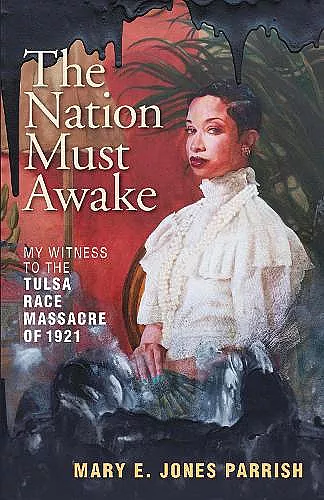The Nation Must Awake
My Witness to the Tulsa Race Massacre of 1921
Mary E Jones Parrish author Ajamu Kojo illustrator John Hope Franklin editor Scott Ellsworth editor
Format:Paperback
Publisher:Trinity University Press,U.S.
Published:8th Jul '21
Should be back in stock very soon

Mary Parrish was reading in her home when the Tulsa race massacre began on the evening of May 31, 1921. Parrish’s daughter, Florence Mary, called the young journalist and teacher to the window. “Mother,” she said, “I see men with guns.” The two eventually fled into the night under a hail of bullets and unwittingly became eyewitnesses to one of the greatest race tragedies in American history. Spurred by word that a young Black man was about to be lynched for stepping on a white woman’s foot, a three-day riot erupted that saw the death of hundreds of Black Oklahomans and the destruction of the Greenwood district, a prosperous, primarily Black area known nationally as Black Wall Street. The murdered were buried in mass graves, thousands were left homeless, and millions of dollars worth of Black-owned property was burned to the ground. The incident, which was hidden from history for decades, is now recognized as one of the worst episodes of racial violence in the United States. The Nation Must Awake, published for a wide audience for the first time, is Parrish’s first-person account, along with the recollections of dozens of others, compiled immediately following the tragedy under the name Events of the Tulsa Race Disaster. With meticulous attention to detail that transports readers to those fateful days, Parrish documents the magnitude of the loss of human life and property at the hands of white vigilantes. The testimonies shine light on Black residents’ bravery and the horror of seeing their neighbors gunned down and their community lost to flames. Parrish hoped that her book would “open the eyes of the thinking people to the impending danger of letting such conditions exist and in the ‘Land of the Free and the Home of the Brave.’ ” Although the story is a hundred years old, elements of its racial injustices are still being replayed in the streets of America today. Includes an afterword by Anneliese M. Bruner, Parrish’s great-granddaughter, and an introduction by the late historian John Hope Franklin and Scott Ellsworth, author of The Ground Breaking: An American City and Its Search for Justice.
“The first and possibly only comprehensive first-person account of the event.”― POLITICO “[Bruner is] honoring her great-grandmother’s groundbreaking journalism”― Vox “The first and most visceral long-form account of how Greenwood residents experienced the massacre.” ― The New Yorker "A story of survival...remains relevant a century later." ― The New York Times "The book is more than just a historical account. It's also Parrish's plea for America to live up to the promise of democracy." ― NPR's Morning Edition "An eyewitness account of the one of the worst events in American history has become a sleeper bestseller for Trinity University Press before the book’s official pub date." ― Publishers Weekly "Mary documents the mind-numbingly large losses of lives and destruction of property through her own eyes and other testimonies from Black residents." ― TheRoot.com "As a historical record, Mary Jones Parris’s book is really rich...especially like the way she itemized a list of all the lost property from the Tulsa massacre, so if ever there was a case for reparations, this is it." ― MS Magazine "The book recalls what it was like in the moments immediately before the mob ransacked the Parrish family home in Greenwood and then takes readers through how Parrish and her young child, Bruner’s grandmother Florence Mary Parrish Bruner, escaped the violence and what they witnessed as their neighborhood burned." ― NBC.com "Essential reading." — BitchReads "The most important single source of the history of the massacre." — Scott Ellsworth, author of The Ground Breaking: An American City and Its Search for Justice "An extremely important, frequently cited, and quite special book in that it offers a rare, first-hand account of the Tulsa Race Massacre." — Public Radio Tulsa "[This book] has served as a primary source for almost every historian of the Tulsa Race Massacre." — Tulsa World "Bruner makes direct comparisons between the events of Tulsa in 1921 and the America of today, writing that the white mob who stormed the U.S. Capitol on Jan. 6, 2020, was a direct descendent of the 'King Mob' her great-grandmother had written about 100 years earlier." — San Antonio Report
ISBN: 9781595349439
Dimensions: unknown
Weight: unknown